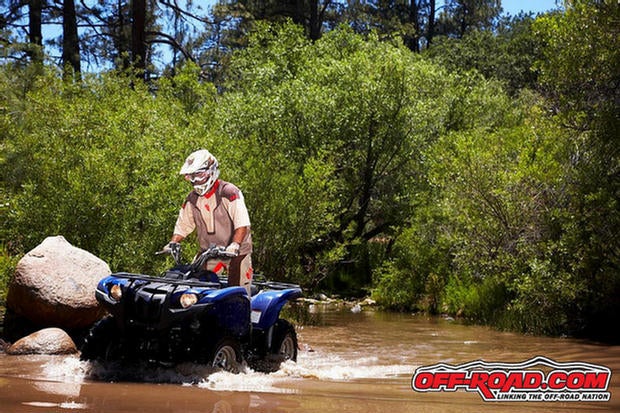
2009 Yamaha Grizzly ATV
The name Grizzly is a powerful and dominating force in the world of ATV’s. The Yamaha Grizzly 700 has ripped its way through the competition like a wild animal, and will remain as a trendsetter. Recently Yamaha engineers developed a new breed of the Grizzly family and it is built with the milder recreational riders in mind.
The San Bernadino National Forest in California would be the location for our testing of the new 2009 Yamaha Grizzly 550 EFI. With vast mountain ranges, elevation changes and tight rocky trails, this was going to prove to us what was good, bad, and ugly in this quad. With the all-new Yamaha Grizzly 550 having advanced EFI fuel delivery, the altitude would pose no problem and getting started on the trail simply meant being focused on the task at hand.
Yamaha has been progressively gaining ground in comfort and handling for the last few years now and this new four wheeler will prove no different. The 2009 Grizzly 550 now comes with optional "EPS" - electric power steering. This feature made headlines when first introduced on the 700cc Yamaha Grizzly. With the race for comfort and control gaining popularity, the engineers had their work cut out for them and they answered with a good plan of attack.
Electric Power Steering
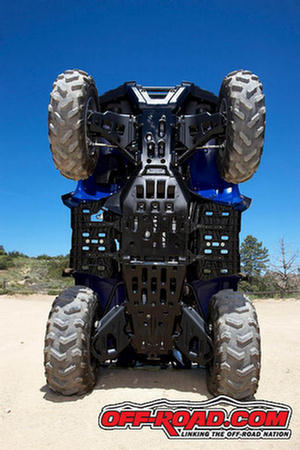
The low speed assist is where you really need it most and it is lightened as the speed increases. The steering assist is seamless at low speeds and as your speed increases the assist in power steering fades to none. This will keep the bars from being to twitchy at high speed. The innovation of power steering has brought a new comfort to recreational riders as well as farm use of this vehicle in that it will take the sting out of hard hits in the trail and make a days work seem effortless.
558cc Engine
The engine of the all-new Grizzly 550 EFI used the 700cc engine as its base. With redesigning the head and flow technology the engineers gained new power for the 558cc engine. Using things like reduction of the overall bore to 92mm, roller rockers, and ceramic composite plating the cylinder make the engine run smooth and with less friction. Old school rockers create friction loss and are not as smooth as a roller rocker. This makes the engine struggle to get the power out and reduces the amount of performance rpm’s that the power plant is able to create. Bottom line is a smooth running engine that is more reliable.
The head of the beast is an all-new item as well. Matching the valve and combustion chambers to make a 558cc engine means getting more bottom end power and improved throttle response. Speaking of throttle response, the new YFI or Yamaha Fuel Injection, is supplied through a 40mm Mikuni throttle body and will compensate for altitudes from 600 feet below sea level up to 15,000 feet above for a very dynamic range of riding opportunities.
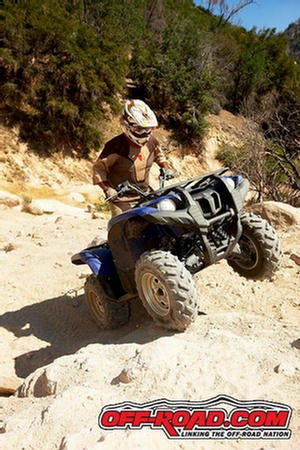 Ultramatic Transmission
Ultramatic Transmission

The Yamaha exclusive “Ultramatic Transmission” is carried into this ATV as well, with a six-shoe configuration and one-way sprag clutch that gives you a more natural engine-braking feeling. Adding to this is the centrifugal clutch design that also eliminates any lag in response by keeping constant belt tension. The intake and exhaust for the CVT tranny is extended up into the center of the Grizzly 500 to make water crossing a worry-free adventure. Although you could still get water into the CVT box it definitely will be harder to do so.
The engine's power is put to the ground through traditional drive shaft technology but Yamaha took it a step further. The driveline was centered up in the frame to give a more direct feed to the tires. This will increase the durability as well. Eliminating U-joints and unnecessary connections helps to also reduce vibration.

CV Boot and A-Arms
The guys at Yamaha realized that CV boot failure was also a common problem and set out to develop some fixes for this hideous transgression to a new quad owner. The boot material is now thicker and its 200% stronger to be exact. This will keep the sticks and branches away from the drive of your new Grizzly 550. The boots on any utility ATV can be torn easily by a passing rock, branch or any obstacle in the trail and adding the tougher boot will make this more difficult. Another great feature is the larger protective A-Arm guards both front and rear that add even more security for the CV boots and driveline.
Braking
Braking is another area of development for the Yamaha Grizzly and with a rear brake master cylinder mounted on the left side of the bars it is very easy to forget about the foot pedal. This has long been a request for most experienced riders and is great for speed demons who tend to overshoot the corners. The fact that the front and rear braking controls are separate is also a great addition to the 550. The four-wheel hydraulic brakes make this a fast stopping machine as well.
Comfort and Control
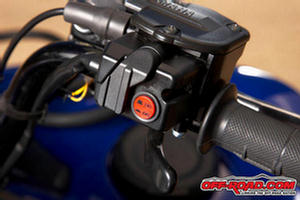
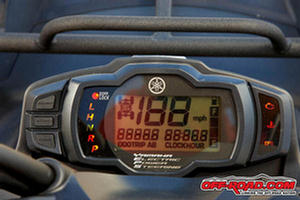
The gas tank is mounted right in the center of the Grizzly for better mass centralization and it does feel a bit more nimble than its larger displacement sibling. The awesome new digital control panel has our final offering as it contains valuable information that will keep you on track and keep your machine running properly by letting you know what is going on. The compact yet highly visible panel tells you your speed, odometer reading, trip logs along with the time of day. It also lets you know what gear or drive you are in and how much fuel you have left. The best thing about this ride buddy is it can even help you diagnose when it is running poorly or in need of maintenance.
 |
 |
Ride Impressions
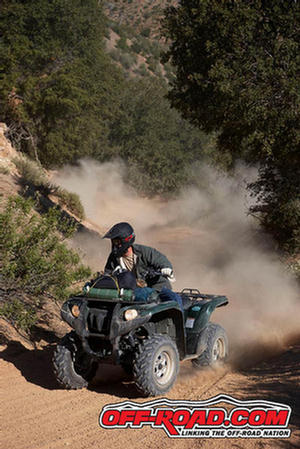
The first thing I noticed was the left bar mounted rear brake control. This became my new best friend all day. The ease of braking control became second nature and before I realized it I had the Grizzly 550 stroking out the trail and backing into the corners like a pro.
Although the engine seemed a little weak on the bottom in high range, it peps up just a bit higher into the rpm’s. The rear brake pedal seemed hard to find and it was a little high in my precarious moments but with seat time it will likely find its place.
Steering was our focus in the rough tight trails, and man, it soaked up some nasty bites during the ride with little to no transfer to the rider. There were moments when I thought, "Wow, I’m gonna get it right here..." and I didn’t even feel it. This is great for riders who make common mistakes but I wonder how much the machine can handle itself before giving in to the g-outs and rock ledges? Something has to give in the rider / quad relationship and I guess I’d rather bend or break the machine than me.
We made several deep-water crossings with little to no effort and the machine never hesitated once. The new air box has a special water trap that helps keep any unwanted drippage from getting to the carb. I do have to say that the cvt snorkels being close to the front and center did add a bit of noise to the ride, but with all the fun we had riding this machine it really didn’t matter.

The suspension has remarkably high center for tough obstacles and it cleared everything I found to push it up to within reason. The rock ledges we crawled over had some serious climb angles and well placed rock lips that the Grizzly just took down like nothing. Low range really is where the fun is on this machine and when we slowed down to enjoy it there was a whole new range of power waiting for us there.
Our tour lasted about 6-7 hours and I can tell you I never once became tired of riding the new Grizzly 550YFI. It is a must-have for beginners and experienced riders alike. It offers so much fun that one day isn’t enough. Looking like its big brother the 700 Grizzly, this new 550cc class ride will make even the pickiest riders happy.
I can't wait to get our test unit and just ride, ride, ride...
RS
%20Automatic%204X4%20-%20Product%20Image%20-%20Blue.jpg)
2009 Grizzly 550 FI (EPS) Automatic 4X4
Engine Type – 558cc, 4-Stroke Single, Liquid Cooled w/ Fan, SOHC
Bore x Stroke – 92mm x 84mm
Compression Ratio – 9.3:1
Carburetion – Yamaha Fuel Injection (YFI) , 40mm
Ignition – 32 Bit ECU
Starting System – Electric
Transmission – Yamaha Ultramatic V-Belt
Engine Braking – All Wheel
Drive Train – Yamaha On-Command push button 3-way locking differential, 2WD, 4WD, locked 4WD; Shaft
Suspension/ Front – Independent Double Wishbone, 7.1” w/ 5-way Preload Adjustment.
Suspension/ Rear – Independent Double Wishbone, 9.5” w/ 5-way Preload Adjustment.
Brakes/ Front – Dual Hydraulic Disc,
Brake/ Rear – Dual Hydraulic Disc,
Tires/ Front – AT25x8-12 w/ Aluminum Wheels
Tires/ Rear – AT25x10-12 w/Aluminum Wheels
LxWxH – 81.3”x46.5”x48.8”
Seat Height – 35.6”
Wheel Base – 49.2”
Turning Radius – 126”
Ground Clearance – 11.8”
Fuel Capacity – 5.3 Gallons
Dry Weight – 600 Lbs
Rack Capacity – 99 Lbs.Fr. / 187 Lbs. Rr.
Towing Capacity – 1,322 Lbs.
Instrumentation – Digital LCD Multi-function display. Speedo, Odo, Dual Trip, Hour, Clock, Fuel, and Gear Position
Lighting – Dual 35W Halogen Multi-reflector Headlights & 21/5W Brake light


 Your Privacy Choices
Your Privacy Choices